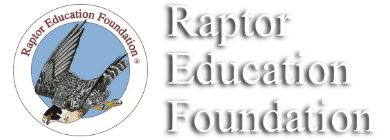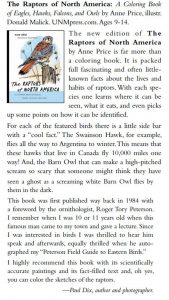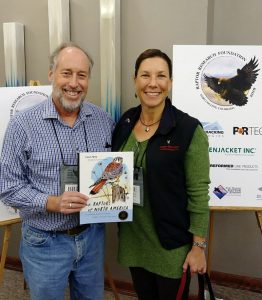| Winner of the 2020 Skipping Stones Honor Award For Nature and Ecology Books. Click to enlarge More Reviews: “A unique book aimed at introducing young and beginning birders to the world of raptors. . . . Creative for certain! Helpful, too.”–Jim Williams, Wingnut blog, Minneapolis Star Tribune “A very cool new book.”–Doc Kirby, On The Bookshelf “Bird enthusiasts of all ages will find this book full of educational fun.”–Skipping Stones “Beautiful, educational coloring book.”–Katie L. Burke, American Scientist “All the essays were well-written and provided lots of easy-to-understand information, which allows the reader to identify many different types of raptors. I also really enjoyed the further reading at the back of the book about the kestrel box. The instructions were clear-cut, and the activity was easy and fun to do.”–Hannah, age thirteen, Kids’ BookBuzz Review from Brian Millsap, President, Raptor Research Foundation This original review of our book was written in 2003. Anne Price has incorporated Brian Millsap’s comments and with the completely new design, our book will continue to reflect the best in science and art to promote raptor conservation in the 21st Century.
|
Raptor Education Foundation is a Certified Mile High United Way Affiliated Agency
Mile High United Way: (REF) Designation Code: 0294. REF is a 501-C-3 scientific & educational charitable organization. All contributions are tax deductible as allowed for by IRS regulations. REF has never received operational support from any governmental agencies. We are supported by public and private contributions using a variety of programs and services. Established in 1980, we are Colorado's first and oldest raptor sanctuary.
- Admin Staff
- Anne Price — President, Peter Reshetniak — Founder
- Jamie Ziegler — Guest Experience Director
- Raptor Staff
- Anne Price — Curator
- Research & Project Associates
- David Goode, Architect:Eagles Landing
- Mews Managers
- Savannah Grout & Karen Ogle
- Docent & Volunteer Staff
- Kristy Bortz, Clarissa Cigrand, Megan Considine, Karen Gonzalez, Kim Kistler, Linda Julia, Jackson Lincoln, Jennifer McAllister, Karen Ogle, Mary Ann Ottinger, Anne Price, Jennifer Redmond, Peter Reshetniak, Beverly Rice, Mitch Skinner, Ann Stanz, Jamie Ziegler
- Docents In Training
- Robert Mitchell, Peggy Plaus
- IT Support
- Trey Spangenberg
- Legal Eagles
- Fairfield & Woods
- ISP
- ECENTRAL
Privacy Policy
REF holds any and all information it gathers regarding its members, clients, supporters, partners, and funders in the strictest confidence. We do not sell or give away names to any entity whatsoever, except as required by law.
Raptor Education Foundation © 2015


